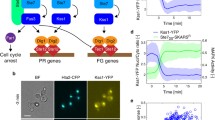Abstract
IN the budding yeast Saccharomyces cerevisiae, the process of conjugation of haploid cells of genotype MATa and MATαto form MATa/α diploids is triggered by pheromones produced by each mating type. These pheromones stimulate a cellular response by interaction with receptors linked to a heterotrimeric G protein. Although genetic analysis indicates that the pheromone signal is transmitted through the Gβγ dimer, the initial target(s) of G protein activation remain to be determined. Temperature-sensitive cells with mutations of the CDC24 and CDC42 genes, which are incapable of budding and of generating cell polarity at the restrictive temperature1–3, are also unable to mate4. Cdc24 acts as a guanylyl-nucleotide-exchange factor for the Rho-type GTPase Cdc425, which has been shown to be a fundamental component of the molecular machinery controlling morphogenesis in eukaryotic cells6–10. Therefore, the inability of cdc24 and cdc42 mutants to mate has been presumed to be due to a requirement for generation of cell polarity and related morphogenetic events during conjugation. But here we show that Cdc42 has a direct signalling role in the mating-pheromone response between the G protein and the downstream protein kinase cascade.
Similar content being viewed by others
References
Hartwell, L. H., Mortimer, R. K., Culotti, J. & Culotti, M. Genetics 74, 267–286 (1973).
Sloat, B. F., Adams, A. E. M. & Pringle, J. R. J. Cell Biol. 89, 395–405 (1981).
Adams, A. E. M., Johnson, D. I., Longnecker, R. M., Sloat, B. F. & Pringle, J. R. J. Cell Biol. 111, 131–142 (1990).
Reid, B. J. & Hartwell, L. H. J. Cell Biol. 75, 355–365 (1977).
Zheng, Y., Cerione, R. & Bender, A. J. biol. Chem. 269, 2369–2372 (1994).
Munemitsu, S. et al. Molec. cell. Biol. 10, 5977–5982 (1990).
Shinjo, K. et al. Proc. natn. Acad. Sci. U.S.A. 87, 9853–9857 (1990).
Miller, P. J. & Johnson, D. I. Molec. cell. Biol. 14, 1075–1083 (1994).
Chang, E. et al. Cell 79, 131–141 (1994).
Chen, W., Lim, H. H. & Lim, L. J. biol. Cnem. 268, 13280–13285 (1993).
Oehlen, L. J. W. M. & Cross, F. R. Genes Dev. 8, 1058–1070 (1993).
Leberer, E., Dignard, D., Harcus, D., Thomas, D. Y. & Whiteway, M. EMBO J. 11, 4815–4824 (1992).
Ramer, S. W. & Davis, R. W. Proc. natn. Acad. Sci. U.S.A. 90, 452–456 (1993).
Manser, E., Leung, T., Salihuddin, H., Zhao, Z. & Lim, L. Nature 367, 40–46 (1994).
Segall, J. E. Proc. natn. Acad. Sci. U.S.A. 90, 8332–8336 (1993).
Jackson, C. L., Konopka, J. B. & Hartwell, L. H. Cell 67, 389–402 (1991).
Ziman, M. et al. Molec. Biol. Cell 4, 1307–1316 (1993).
Fields, S. & Sternglanz, R. Trends Genet. 10, 286–292 (1994).
Gyuris, J., Golemis, E., Chertkov, H. & Brent, R. Cell 75, 791–803 (1993).
Johnson, D. I. & Pringle, J. R. J. Cell Biol. 111, 143–152 (1990).
Ziman, M., O'Brien, J. M., Ouellette, L. A., Church, W. R. & Johnson, D. I., Molec. Cell. Biol. 11, 3537–3544 (1991).
Madaule, P., Axel, R. & Myers, A. M. Proc. natn. Acad. Sci. U.S.A. 84, 779–783 (1987).
Matsui, Y. & Toh-e, A. Gene 114, 43–49 (1992).
Powers, S. et al. Cell 36, 607–612 (1984).
Hutter, K. J. & Eipel, H. E. J. gen. Microbiol. 113, 369–375 (1979).
Martin, G. A., Bollag, G., McCormick, F. & Abo, A. EMBO J. 14, 1970–1978 (1995).
Bender, A. & Pringle, J. R. Yeast 8, 315–323 (1992).
Richardson, H. E., Wittenberg, C., Cross, F. & Reed, S. I. Cell 59, 1127–1133 (1989).
Elble, R. Biotechniques 13, 18–19 (1989).
Miller, J. H. Experiments in Molecular Genetics (Cold Spring Harbor Laboratory Press, New York, 1972).
Author information
Authors and Affiliations
Rights and permissions
About this article
Cite this article
Simon, MN., Virgilio, C., Souza, B. et al. Role for the Rho-family GTPase Cdc42 in yeast mating-pheromone signal pathway. Nature 376, 702–705 (1995). https://doi.org/10.1038/376702a0
Received:
Accepted:
Issue Date:
DOI: https://doi.org/10.1038/376702a0
- Springer Nature Limited
This article is cited by
-
A framework for mapping, visualisation and automatic model creation of signal‐transduction networks
Molecular Systems Biology (2012)
-
The role of adaptor protein Ste50-dependent regulation of the MAPKKK Ste11 in multiple signalling pathways of yeast
Current Genetics (2003)
-
Polarized localization of yeast Pbs2 depends on osmostress, the membrane protein Sho1 and Cdc42
Nature Cell Biology (2000)
-
The yeast pheromone-responsive Gα protein stimulates recovery from chronic pheromone treatment by two mechanisms that are activated at distinct levels of stimulus
Cell Biochemistry and Biophysics (1999)
-
A GTP-exchange factor required for cell orientation
Nature (1998)





